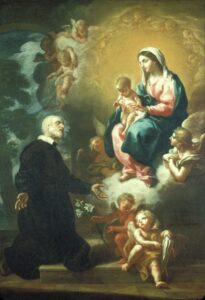 Saint Philip Neri, who founded the Congregation of the Oratory in Sixteenth Century Rome, had a deep devotion to the Blessed Virgin Mary. One of his maxims, or a saying he was always teaching his sons in the Oratory and the men and women who came to him for spiritual direction was, “Devotion to the Blessed Virgin is actually necessary, because there is no better means of obtaining God’s graces than through His most holy mother” (Maxims of St. Philip Neri, 2 February). The saint’s own experience taught him this, as was recorded by his biographers and his own writings. For us, today, St. Philip’s teaching on devotion to Our Lady is just as important as it was to those who knew him during his lifetime. “To begin and end well,” St. Philip would say, “devotion to our Blessed Lady, the Mother of God, is nothing less than indispensable” (Maxims, 5 August). But how did St. Philip advise us to approach Our Lady?
Saint Philip Neri, who founded the Congregation of the Oratory in Sixteenth Century Rome, had a deep devotion to the Blessed Virgin Mary. One of his maxims, or a saying he was always teaching his sons in the Oratory and the men and women who came to him for spiritual direction was, “Devotion to the Blessed Virgin is actually necessary, because there is no better means of obtaining God’s graces than through His most holy mother” (Maxims of St. Philip Neri, 2 February). The saint’s own experience taught him this, as was recorded by his biographers and his own writings. For us, today, St. Philip’s teaching on devotion to Our Lady is just as important as it was to those who knew him during his lifetime. “To begin and end well,” St. Philip would say, “devotion to our Blessed Lady, the Mother of God, is nothing less than indispensable” (Maxims, 5 August). But how did St. Philip advise us to approach Our Lady?
St. Philip promoted the Marian Rosary as revealed to St. Dominic, and which has been recommended by so many saints and popes: the traditional Joyful, Sorrowful, and Glorious Mysteries consisting of five decades of one Our Father and ten Hail Marys sometimes known as Our Lady’s Psalter, since the “full” rosary consists of 150 Hail Marys. St. Philp was known to recommend a daily Rosary of at least five decades, and he taught his penitents, “It is a good thing, during the week that follows our communion-day, to do something more than usual; for example, to say … an extra Rosary”(Maxims, 10 June).
St. Philip also taught a unique devotion to his sons in the Oratory and to those who came to him for spiritual counsel: “To obtain the protection of our Blessed Lady in our most urgent wants, it is very useful to say sixty-three times, after the fashion of a Rosary, ‘Virgin Mary, Mother of God, pray to Jesus for me’” (Maxims, 7 September). Known as the Philippine Rosary, or the Chaplet of St. Philip Neri, this devotion consists of six decades of the prayer recommended by the saint: “Virgin Mary, Mother of God, pray to Jesus for me” on the Hail Mary beads. While the saint did not propose a prayer for the Our Father beads, he did teach, “When we make this prayer to our Blessed Lady,” that is, the prayer he recommends in his chaplet, “we give [the Blessed Lady] every possible praise in the least possible compass, because we call her by her name of MARY, and give her those two great titles of ‘Virgin,’ and ‘Mother of God,’ and then name JESUS, the fruit of her most pure womb” (Maxims, 8 September). Those two titles, then, are worth repeating. Therefore, some Oratorians will offer the invocation, “Virgin and Mother, Mother and Virgin,” on the Our Father beads.
How to pray the Rosary of St. Philip Neri
- Remember: this devotion does not take the place of the traditional, Marian Rosary.
- Use a regular set of Rosary beads for the prayer.
- There are six decades, or sets of prayers, as given below.
- On the large Our Father Bead, say, “Virgin and Mother, Mother and Virgin,” contemplating what St. Philip called “these two great titles” of Our Lady.
- On the ten Hail Mary Beads, say the prayer recommended by St. Philip, “Virgin Mary, Mother of God, pray to Jesus for me.”
- It is praiseworthy, at the end of each of the six decades, to offer the Glory Be: “Glory be to the Father, and to the Son, and to the Holy Spirit: as it was in the beginning, is now, and ever shall be, world without end. Amen.”
- After the six decades, offer St. Philip’s prayer thrice more, in honour of the Father, the Son, and the Holy Spirit.
- You may conclude with one of the Marian Antiphons, such as “Hail, Holy Queen,” or the antiphon of the current season, such as “Alma Redemptoris Mater,” “Ave Regina Cælorum,” or “Regina Cœli.”
Offering the Philippine Rosary does not replace one’s devotion to the Dominican or Marian Rosary, which so has been so often enriched with indulgences and lauded for its power with Our Divine Saviour. Instead, it serves as a beautiful addition to deepen one’s Marian piety, which always leads us back to Jesus, or, indeed, as a gateway or first step to prayer and devotion to the Mother of God.